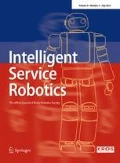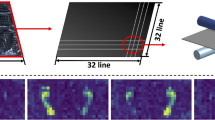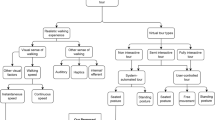Abstract
The key issue in this paper is estimating speed of a human. Compared with previous researches on walking speed estimation, we predict the walking intention before gait action. Our proposed hypothesis is that a composite force index is linearly correlated with the intended walking speed. We did two experiments to test the hypothesis. One gives a regression test indicating the intended walking speed has strong linear correlation with the proposed force index; the other tests the linearity by statistical analysis, guaranteeing the tolerance of individual difference. According to the regression and statistics analyses, we built a treadmill-style locomotion interface. Compared with the normal cases of treadmill control, the tested subject does not have to follow the speed of treadmill, but can actively change the speed of treadmill by his/her feet. The designed locomotion interface is applied in a virtual market system. Here the subject walks in a virtual market street with the desired speed. The stereo display based on virtual reality and the ambient sounds of the environment make the subject to have an immersed sense. The layout of shops in the virtual market system is in Japanese style, making the subjects experience much more realistic.
Similar content being viewed by others
References
Noma H, Miyasato T (1998) Design for locomotion interface in a large scale virtual environment ATLAS: ATR locomotion interface for active self motion. In: 7th annual symposium on haptic interface for virtual environments and teleoperated systems
Darken RP, Cockayne WR (1997) The omni-directional treadmill: a locomotion device for virtual worlds. In: 10th annual ACM symposium on user interface software and technology
Iwata H, Yoshida Y (1999) Path reproduction tests using a Torus treadmill. Teleoper Virtual Environ 8: 587–597
Hollerbach JM, Christensen R (2000) Design specifications for the second generation Sarcos Treadport locomotion interface. In: Haptics symposium of ASME dynamic systems and control division
Christensen R et al (2000) Inertial force feedback for the Treadport locomotion interface. Teleoper Virtual Environ 9: 1–14
Muybridge E (1955) The human figure in motion. Dover Publications, USA
Herren R et al (1999) The prediction of speed and incline in outdoor running in humans using accelerometry. Med Sci Sports Exerc 31: 1053–1059
Vathsangam H et al (2010) Toward free-living walking speed estimation using Gaussian process-based regression with on-body accelerometers and gyroscopes. In: 4th international conference on pervasive computing technologies for healthcare
Bendall MJ, Bassey EJ, Pearson MB (1989) Factors affecting walking speed of eldly people. Age Ageing 18: 327–332
Su S et al (2005) Estimation of walking energy expenditure by using support vector regression. In: 27th annual international conference of the engineering in medicine and biology society
Rothney M et al (2007) An artificial neural network model of energy expenditure using nonintegrated acceleration signals. J Appl Physiol 103: 1419–1427
Bonomi AG, Salati S (2010) Assessment of human ambulatory speed by measuring near-body air flow. Sensors 10: 8705–8718
Dong H, Luo Z, Nagano A (2010) Adaptive treadmill control by human will, in emerging trends in mobile robotics. World Scientific, New Jersey, pp 1185–1194
Dong H, Meng J, Luo Z (2011) Real-time estimation of human’s intended walking speed for treadmill-style locomotion interfaces. In: 8th international conference on ubiquitous robots and ambient intelligence
Rebsamen B, et al (2006) A brain-controlled wheelchair based on P300 and path guidance. In: IEEE international conference on biomedical robotics and biomechatronics
Ivancevic VG, Ivancevic TT (2005) Natural biodynamics. World Scientific Publishing Co. Pte. Ltd., New Jersey
Winter DA (1990) Biomechanics and motor control of human movement, second edn. Wiley, London
Jamieson LP, Hunt KJ, Allan DB (2008) A treadmill control protocol combining nonlinear, equally smooth increases in speed and gradient: Exercise testing for subjects with gait and exercise limitations. Med Eng Phys 30: 747–754
Schutz Y et al (2002) A new accelerometric method to assess the daily walking practice. Int J Obes 26: 111–118
Hollerbach JM (2002) Locomotion interfaces, in Handbook of virtual environments: design, implementation, and application. Lawrence Erlbaum Associates, NJ, pp 239–254
Author information
Authors and Affiliations
Corresponding author
Electronic Supplementary Material
Rights and permissions
About this article
Cite this article
Dong, H., Luo, Z., Nagano, A. et al. An adaptive treadmill-style locomotion interface and its application in 3-D interactive virtual market system. Intel Serv Robotics 5, 159–167 (2012). https://doi.org/10.1007/s11370-012-0110-6
Received:
Accepted:
Published:
Issue Date:
DOI: https://doi.org/10.1007/s11370-012-0110-6




